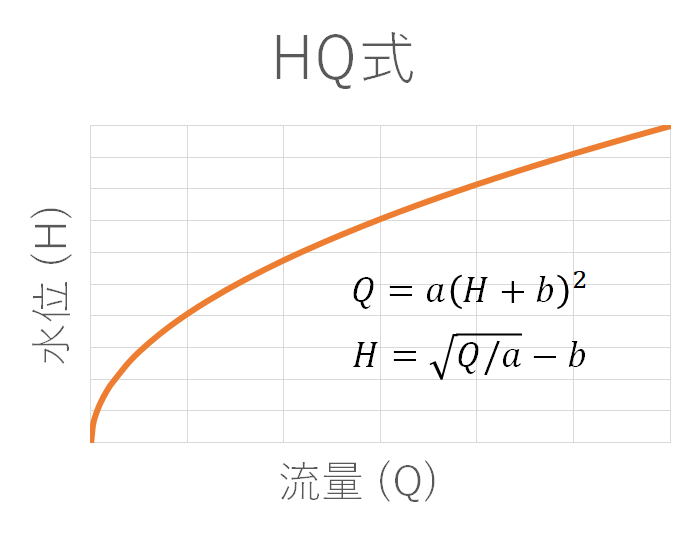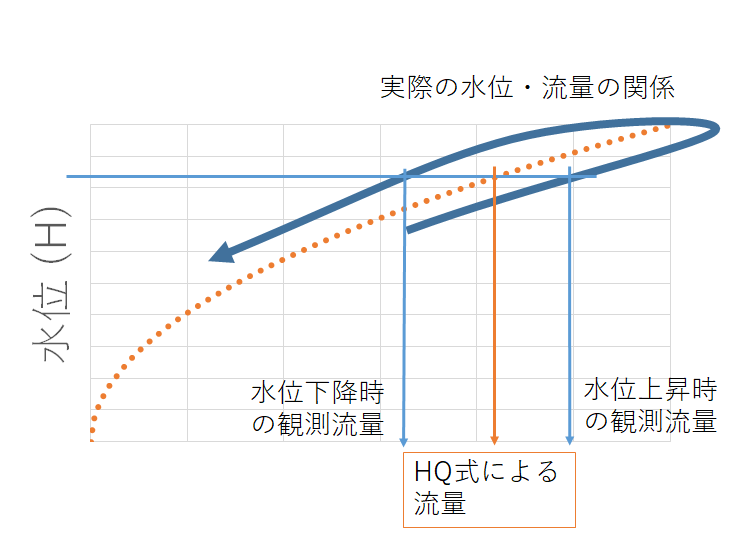FAQ / What is HQ Formula?¶
The HQ equation shows the relationship between the water level (H) and the flow rate (Q). Also known as the H-Q curve or stage discharge rating curve.
 Figure: HQ formula graph
Figure: HQ formula graph
The HQ formula generally expresses the flow rate as the square of the water level as follows:
River Sabo Technical Standards Survey (June 24) Chapter 2 Section 4 p. 29 Formula 2-4-3
where \(a\): coefficient, \(b\): coefficient. These coefficients are inferred from past observations. Also, \(H > -b\). Therefore, the HQ expression is a monovalent function. For this reason, you can define the following inverse function:
where \(Q > is 0\).
Since the flow rate (Q) is obtained from the water level (H), it is called the HQ formula.
In the case of the HQ formula, graphs with H on the vertical axis and Q on the horizontal axis are often used. By setting the vertical axis to H, it is possible to draw a river cross section map superimposed on an HQ type graph.
The HQ formula is a very convenient formula that allows you to determine the flow rate from the water level. In general, measuring river flow is very challenging. In comparison, it is easier to measure river water levels. Using the HQ formula, the river flow rate can be estimated from the river water level, avoiding the difficulty of directly measuring the river flow. For this reason, the HQ formula has been widely used in practice.
 Figure: Deviation between the HQ formula and the actual water level and flow rate
Figure: Deviation between the HQ formula and the actual water level and flow rate
On the other hand, it is known that the flow rate obtained by the HQ equation can contain many errors. For example, even at the same water level, the flow rate when the water level drops may be smaller than when the water level rises. This is because when the water level rises, the water surface slope is larger than when the water level falls, and the flow velocity is faster. In this case, the graph draws a counterclockwise trajectory (loop). What you mean
If the loop is approximated by a single water level flow curve, the water level flow curve multiplies the converted flow rate by a considerable error.
It will be.
For this reason,
River Sabo Technical Standards Survey (June 24) Chapter 2 Section 4 p. 29
In a slow-flowing river, the influence of changes in water surface gradient due to the influence of backwaters due to tides, confluences, weir operations, etc. on the downstream side cannot be ignored, so the water level flow curve cannot be expressed as a univalent function of the water level only. Therefore, it is desirable not to use the water level flow curve method at such points.
It is said.
On the other hand, in the practice of flood analysis, it is required to use the inverse function of the HQ formula to obtain the water level from the flow rate obtained by simulation.
Manual for Drawing Flood Expected Areas (4th Edition) July 27 p. 11
For the calculation of the river channel water level, the river channel water level is calculated from the flow rate based on the irregular flow calculation by the H-Q formula using the water level calculation method used in the above-mentioned river channel plan.
However, if you give the HQ formula a flow rate of 0 or a negative value, the water level becomes imaginary. In other words, it is inappropriate to apply the HQ equation to places where such flow is slow or where reverse flow occurs. Care must be taken when handling HQ formulas in these areas.
Manual for Drawing Flood Expected Areas (4th Edition) July 27 p. 9
In the calculation of the flood start flow rate, if the flow capacity is significantly overestimated or underestimated due to the influence of structures such as weirs, the H-Q equation is not mechanically created from the hydraulic calculation results, but the H-Q equation is corrected as necessary or removed from the expected flood point described later in consideration of the hydraulic characteristics of the section so that the flow capacity is appropriate.
In addition, if the HQ equation is to be applied when the river water level exceeds the height of the embankment, it is necessary to extrapolate the HQ equation. This is also something to keep in mind.
Manual for Drawing Flood Expected Areas (4th Edition) July 27 Reference 3 Guidance for Inundation Analysis in the Event of Flooding Exceeding the Plan Scale (Draft) p. 9
According to the hydraulic analysis method and hydraulic conditions used in the river channel plan, the water level of each cross section for each flow rate scale in the current river channel is calculated, and an H-Q formula such as the \(Q = a ( H + b ) ^2\) format is created. River channel water levels may be overestimated. Therefore, when calculating the flow rate equivalent to the height of the levee, it is necessary to pay attention to the upper limit of the overflow water depth, and to use the irregular flow calculated water level that takes flooding into account instead of the converted water level according to the H-Q formula consistent with the river channel plan.